When a bedroom feels like a retreat, it changes everything. Green is more than a color—it’s a mood, a statement, and a lifestyle choice. In this guide, we’ll dive into green bedroom decorating ideas that bring calm, beauty, and a little bit of nature’s power into your everyday life.
Whether you’re drawn to sage, forest, mint, or olive, there’s something deeply comforting about green. It connects us to life, quiets the noise of the day, and makes even the smallest room feel like a peaceful oasis.
Let’s explore what that looks like in real spaces—one idea at a time.
Paint Your Walls with Emotion: Choosing the Right Green for your Bedroom Decor
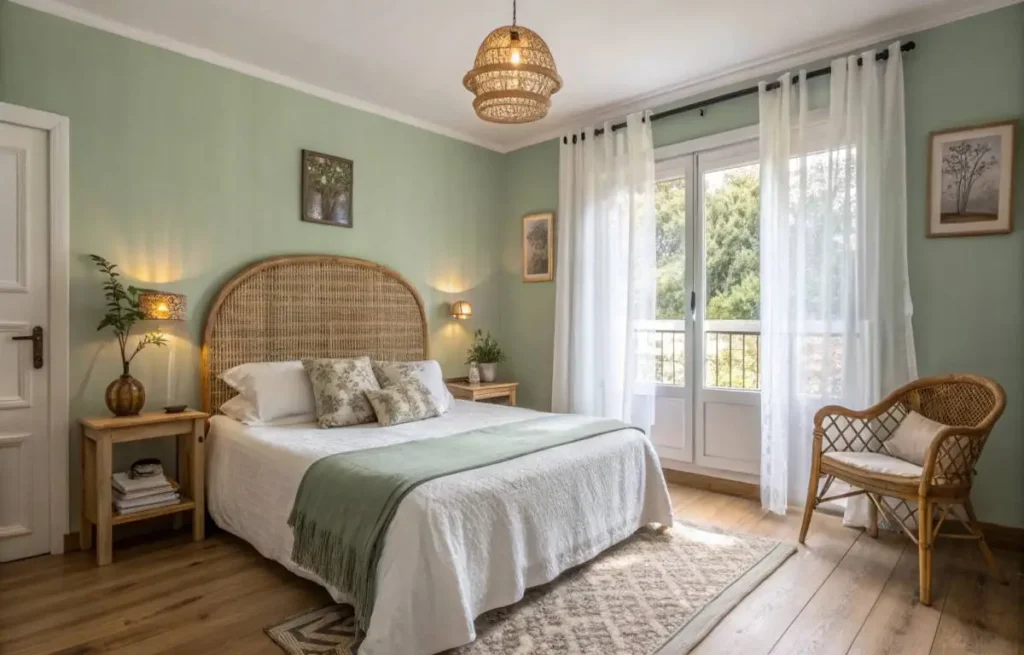
There’s no quicker way to transform your bedroom than painting the walls. But green isn’t just green—it’s layered, emotional, and expressive.
Sage green bedroom walls for a restful retreat
Sage green is no longer a trend—it’s a staple. It’s what Elle Decor called “the new neutral” in 2023 because of its ability to play nice with both warm and cool palettes. Soft, desaturated, and earthy, sage green creates a setting that feels rooted and calm. You’re not just repainting your walls; you’re resetting your nervous system.
Color psychology studies have shown that low-saturation greens like sage can reduce heart rate and blood pressure, making them a smart choice for high-stress environments like bedrooms. A 2019 research article from the Journal of Environmental Psychology even stated that green tones “contribute to sustained relaxation and cognitive clarity when used in intimate indoor spaces.”
What does this mean for your home? A sage green bedroom becomes a sanctuary—especially when paired with creamy whites, dusty blush, or natural oak furniture. It soothes without putting you to sleep.
Bold forest green for a moody, elegant effect
If sage is the spa, forest green is the lounge. This color doesn’t whisper—it makes a statement. Deep, dark greens are ideal for larger rooms or those with high ceilings. They’re moody, dramatic, and loaded with personality.
But they’re not just for drama lovers. According to design firm Studio McGee, dark greens paired with brass accents or soft velvets “create a space that feels expensive without trying too hard.” That’s exactly the energy many want in their bedroom—especially those leaning into a high-end boutique hotel vibe.
A surprising stat? Houzz’s 2023 interior trends report showed a 38% rise in searches for “dark green bedrooms.” That suggests people aren’t afraid of going bold—as long as it’s balanced with soft textiles and warm lighting.
Forest green makes your walls feel close—in a good way. Like the embrace of an old velvet armchair or the shade under a giant tree.
Soft mint green for fresh and airy vibes
If sage is grounding and forest is dramatic, mint is fresh, clear, and slightly whimsical. It works wonders in small bedrooms, guest rooms, or any space that needs a touch of life.
Mint green carries a breezy softness that mimics spring air. It’s especially powerful when used in minimalist rooms with white, light wood, or rattan elements. Apartment Therapy described mint as “an ideal bridge between clean minimalism and youthful color”—something that’s hard to achieve with louder greens.
Studies in chromotherapy suggest that pastel greens like mint can stimulate creative thinking and emotional openness. That makes mint a great choice not only for sleeping but also for dreaming.
Designers often use mint in kids’ bedrooms or shared rooms because it’s gender-neutral and universally loved. And when paired with white sheer curtains or light bamboo flooring? It feels like vacation.
Layer in Natural Textures and Earthy Materials
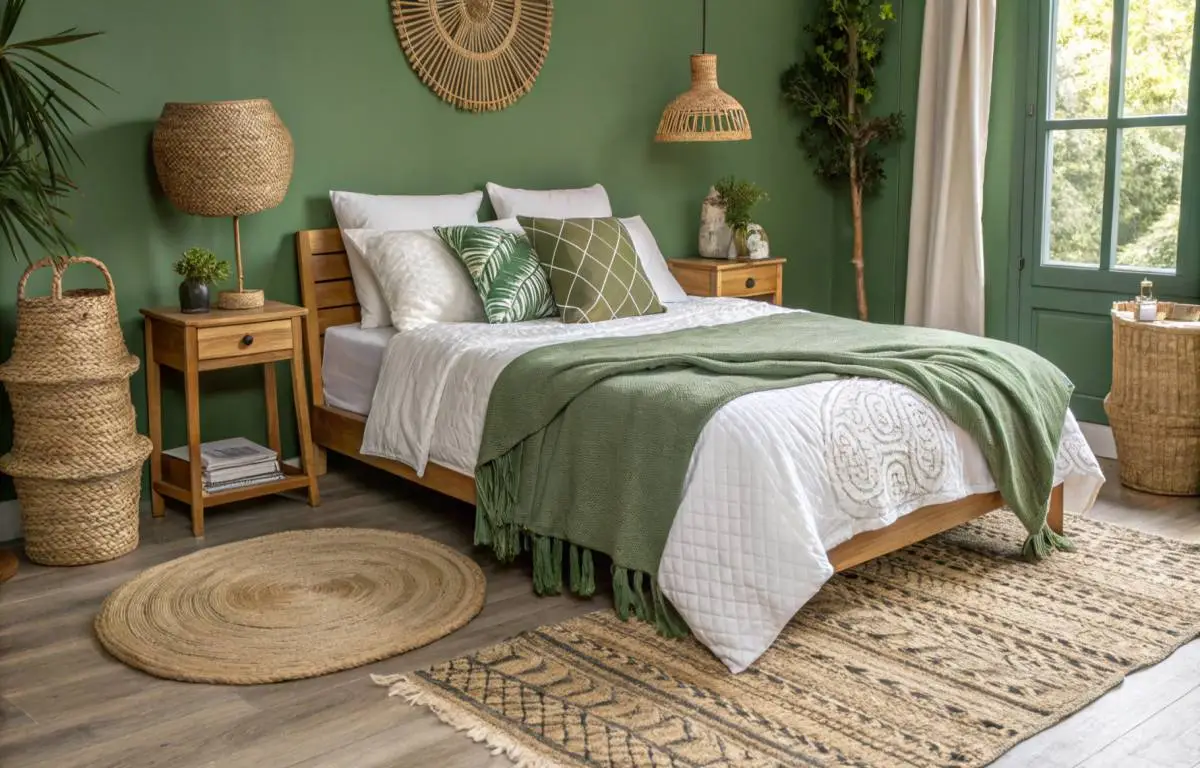
Color alone doesn’t make a space feel organic. It’s what surrounds it—your textures, finishes, and furniture—that builds that grounded, peaceful atmosphere.
Use wood tones to enhance green’s calming effect
Wood and green are a natural match. When paired, they create a bedroom that feels alive and honest. Light woods like oak, birch, or ash bring out the warmth in sage or mint, while darker woods like walnut or acacia add contrast to forest tones.
According to a study published by the University of British Columbia’s Forestry Department, the presence of visible wood in indoor settings contributes to feelings of comfort, reduced stress, and an increased perception of warmth.
This means even a simple oak nightstand or bench can tip the emotional scale toward serenity. Bedrooms with visible wood tend to feel more welcoming—less like a showroom and more like a home.
Try rattan, linen, and jute for natural balance
Materials matter as much as colors. Linen bedding, jute rugs, and rattan storage baskets introduce movement and softness into a room otherwise dominated by flat surfaces. These textures speak the same language as green—they’re unrefined, imperfect, and human.
Designer Justina Blakeney, creator of The Jungalow, often advocates for layering natural materials because “it makes a room feel collected, not decorated.” That’s what we want with green bedrooms: not perfection, but peace.
Don’t underestimate a chunky jute rug underfoot or a loosely woven rattan pendant light. These elements bring a sense of soul, not just style.
Incorporate clay and terracotta for subtle warmth
If your bedroom leans cool with sage or mint, bring in a bit of warmth with terracotta and clay. These materials add an unexpected layer of depth. A single terracotta vase on the dresser or a burnt-orange throw pillow can create a warm counterbalance that makes the green pop without clashing.
Interior stylist Emily Henderson recommends clay-toned accessories in green rooms to “anchor the palette emotionally and keep it from feeling sterile.”
It’s a lesson in contrast: cold isn’t calm unless it’s warmed up in the right places.
Bring Life to the Room with Plants and Greenery with Green bedroom decorating
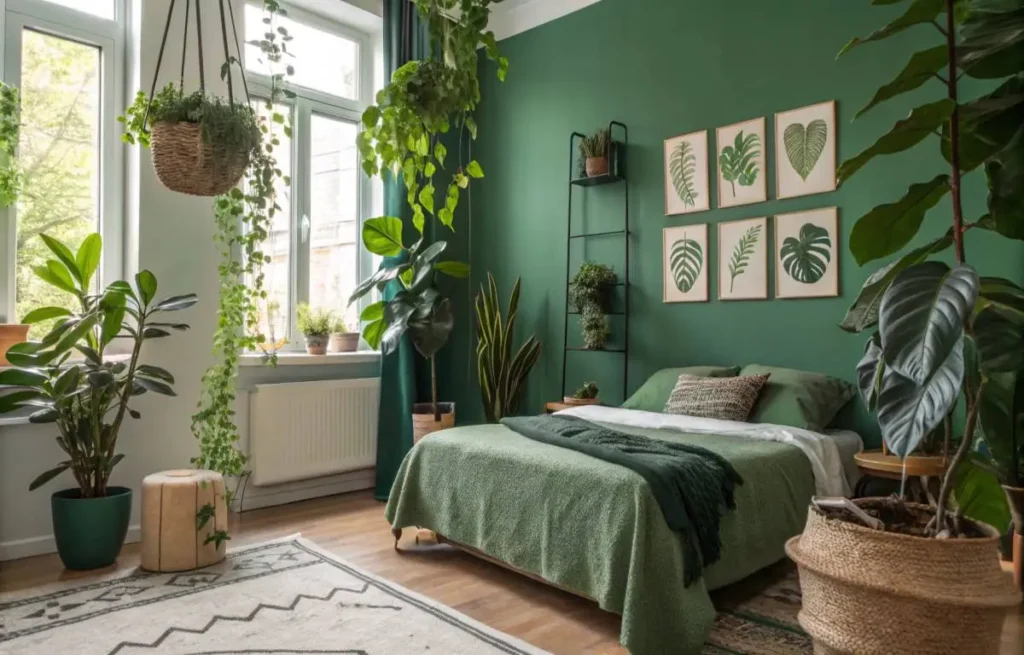
A green bedroom without actual greenery feels incomplete. Adding real (or even faux) plants strengthens the sense of calm and breathability.
Best indoor plants for a green bedroom atmosphere
Snake plants, pothos, ZZ plants, and peace lilies all thrive in low-light conditions typical of many bedrooms. But they do more than look good.
NASA’s Clean Air Study, conducted in the late 1980s and still referenced today, found that indoor plants like these can remove toxins such as formaldehyde and benzene from the air. While modern science has slightly revised the scale of these effects, the emotional benefit is undeniable.
Environmental psychologist Sally Augustin, PhD, has stated that “being around greenery—even in small doses—boosts our mood and helps reduce mental fatigue.”
Your green bedroom should breathe as much as you do. Plants are an affordable, beautiful way to do just that.
Create a mini plant corner for visual harmony
Rather than scatter your plants across the room, group them. Visual cohesion is stronger when plants are placed intentionally in clusters of varying heights.
A tall rubber plant next to a trailing pothos on a floating shelf and a tabletop snake plant creates what designers call a “green moment.” It draws the eye, slows the breath, and fills visual gaps.
You can even layer in ceramic or woven planters to match the surrounding materials. It’s small-space harmony done right.
Use hanging planters or wall-mounted greenery
In bedrooms with limited surface area, go vertical. Macramé plant holders or wall-mounted planters keep greenery in sight but out of the way.
Biophilic design expert Oliver Heath notes that hanging plants in bedrooms can “reintroduce organic forms and a sense of softness, particularly when surfaces are dominated by sharp lines or digital screens.”
In other words, greenery up high balances out the clutter down low.
Add Emotional Lighting and Ambience to Green Bedroom Decorating
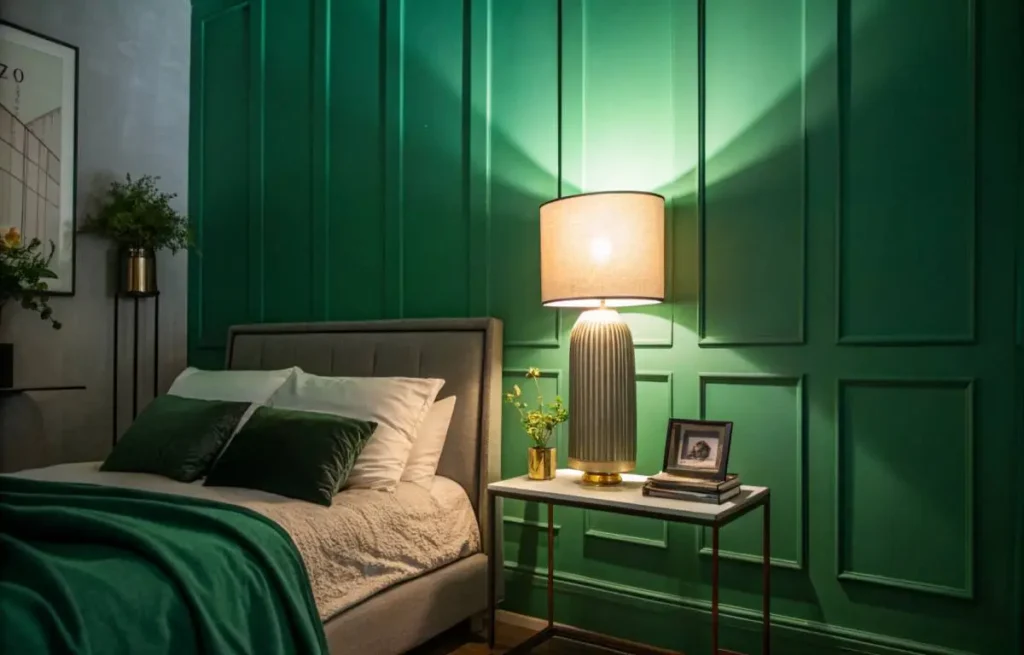
Lighting sets the emotional tone of your bedroom—and green benefits especially well from soft, layered light.
Choose warm lighting to soften green walls
Green tones shift dramatically under different lighting conditions. A beautiful sage can look washed out or sickly under cool-white LEDs.
That’s why lighting experts at Philips Hue recommend bulbs in the 2700K–3000K range for bedrooms, especially if the walls are painted in any shade of green. These warmer tones enhance the natural undertones of green without flattening them.
Even a small change in light temperature can transform your entire palette. Think golden glow—not hospital light.
Use layered lighting for flexible atmosphere
No single light source can create comfort. Combine overhead fixtures with bedside sconces, table lamps, and perhaps string lights or LED strip accents.
The American Lighting Association advises using at least three types of lighting in a bedroom to support different emotional states: alertness in the morning, relaxation in the evening, and intimacy at night.
This approach becomes especially important in a green bedroom, where light can alter the mood dramatically. Test different setups until your space feels like it adapts to you—not the other way around.
Try green-accented lighting pieces or lamps
Want to lean into the green even more? Use lighting as decor. A marble-based lamp in emerald, a moss green glass sconce, or even a jade ceramic base can subtly carry the color theme without repainting anything.
These accents are not only practical—they’re conversation starters. In a bedroom designed to soothe, even your lamp can make a quiet statement.
Personalize with Art, Textiles, and Statement Decor
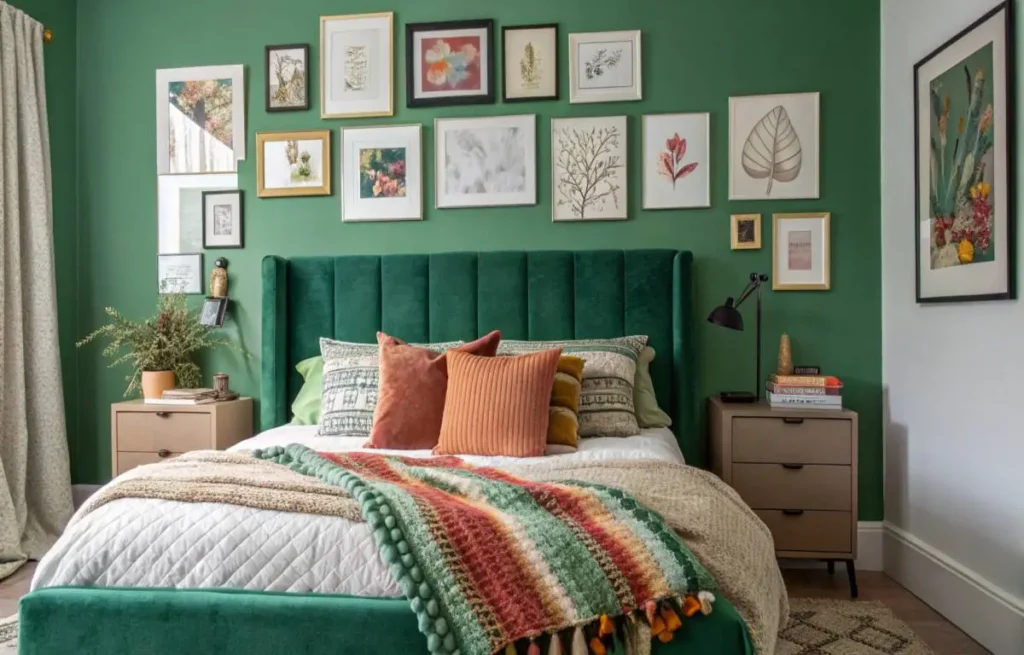
This is where the room becomes yours. Style is personal—and even with a green base, there’s room for interpretation.
Use botanical artwork for nature-inspired harmony
Botanical illustrations, vintage herbarium prints, or even large-scale photography of forests or fields reinforce the connection to nature.
According to neuroaesthetics research, images of nature—even in print form—can stimulate the same calming brain patterns as real outdoor exposure. This makes botanical artwork a powerful and budget-friendly way to amplify the bedroom’s atmosphere.
Frame your art in warm wood or brushed gold to add polish. And don’t overdo it—let the pieces breathe.
Incorporate green tones in pillows, rugs, and throws
Not ready to commit to green paint? Bring the color in through textiles. A forest green velvet pillow, a mossy throw blanket, or a pale mint rug can deliver softness and sophistication.
Layering textures adds depth. Interior designer Sarah Sherman Samuel says, “A monochromatic palette only works when texture does the heavy lifting.” That’s especially true in green bedrooms where subtle shifts in hue create richness.
This method also makes it easy to update your look seasonally.
Add personal items that connect emotionally
A green room doesn’t need to be perfect—it needs to be personal. Include elements that mean something to you: a ceramic piece from your travels, a jade sculpture, a vintage botanical book, or even a childhood photo in a green frame.
These personal touches make the room emotionally functional—not just visually attractive. They remind you who you are and what grounds you.
Because at the end of the day, a bedroom isn’t just for sleeping—it’s for being.
Conclusion
A green bedroom doesn’t have to follow rules—it just has to feel right. Whether you love deep, moody tones or light, airy shades, the right combination of color, texture, light, and emotion can create a space that recharges you daily.
The most powerful green bedroom decorating ideas come from mixing inspiration with personal meaning. Let the color ground you. Let the textures calm you. Let the room tell your story.
And maybe, just maybe, let yourself slow down long enough to enjoy it.
People Also Read
Wallpaper Decor Ideas for Bedroom That Broke the Internet
Hello Kitty Bedroom Decor Every Girl Dreams Of
FAQs
What shade of green is best for a bedroom?
Soft tones like sage, olive, and moss green are calming and ideal for a restful bedroom environment.
Does green make a bedroom look bigger or smaller?
Lighter greens can make a room feel more open, while darker greens create a cozy, intimate space.
What colors go well with green in a bedroom?
Neutrals like white, beige, and wood tones pair beautifully with green, as do soft pinks and brass accents.
Is green a good color for sleep?
Yes, green is associated with nature and calm, which can promote relaxation and better sleep.
How do I decorate a green bedroom without overdoing it?
Balance green with natural textures, soft lighting, and neutral accents to keep the look grounded and stylish.
